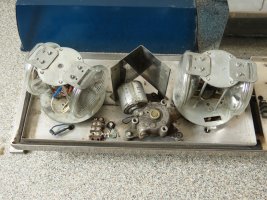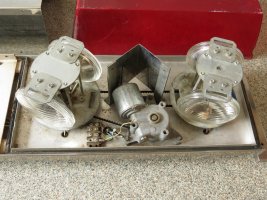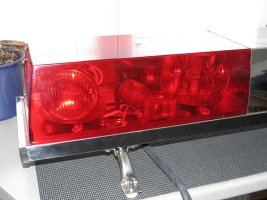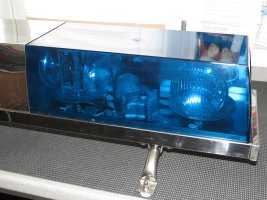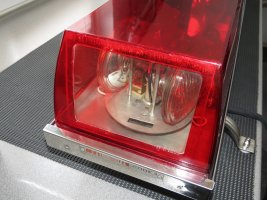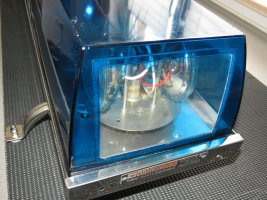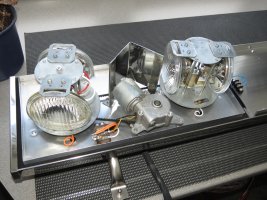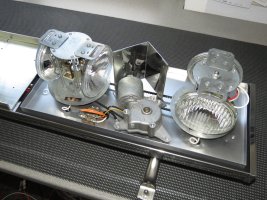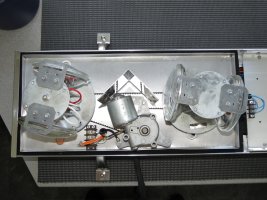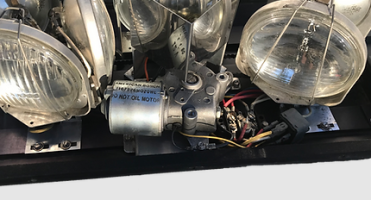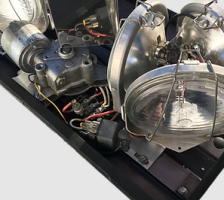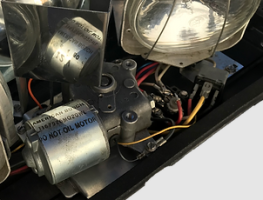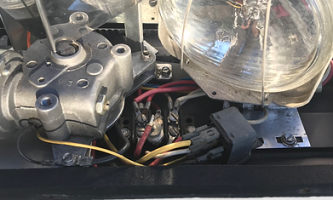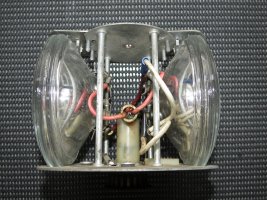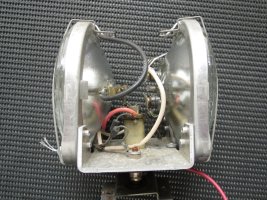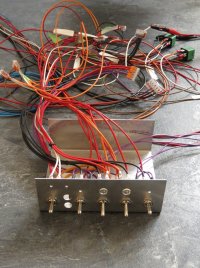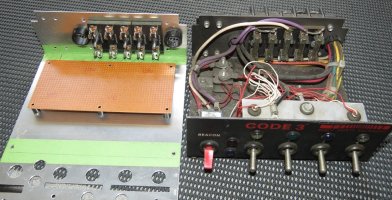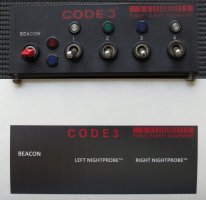You are using an out of date browser. It may not display this or other websites correctly.
You should upgrade or use an alternative browser.
You should upgrade or use an alternative browser.
Code3 SD Bar with SelectAlert + Nightprobe
- Thread starter Benno
- Start date
This back when Code 3 was really leading the industry in some areas. I miss old Code 3. Thanks for keeping a chunk of old Code 3 alive.
There were multiple varieties, but all are belt drive systems with copper contact discs and power brushes protruding down from the bottom of the rotators. The contact plates were divided into sections. When different sections were deenergized the bulbs would go out. The motor would be started and stopped by what the contacts were touching from what I remember too. I may be wrong but I do not recall any feature that didn't somehow use the contact discs in some way.Very impressive. How does it work? It is Jetsonic-ish with the pods stopping at the right spot.
The deluxe models became more advanced with a control to forward and backward advance the lights and make them take downs on clear dome bars. I have a select alert minibar and it simply divides the copper contact places in half and doesn't power half.
This is my example which is just select alert so it doesn't need to trip the motor. https://elightbars.org/forums/threads/code-3-mini-sd-with-select-alert-kinda.94699/
There are a few other threads on here that show partial teardowns, I use google and and "site:elightbars.org" to the search term rather than searching on here directly.
I had the brush and plate system backwards. The plates are often on the rotator, the brushes on the frame. Same idea. They can act as triggers or be triggered for both light and motor function. As stated, the system was cool but often prone to failure and/or underused and thus disabled./\ /\ /\ John pretty much hits it on the head. My experience with select o lert lighting is largely the same. Often this is disabled because of issues and converted to be a normal bar.
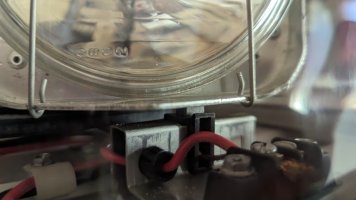
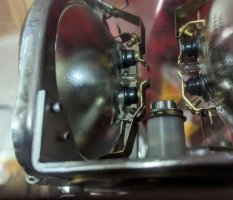

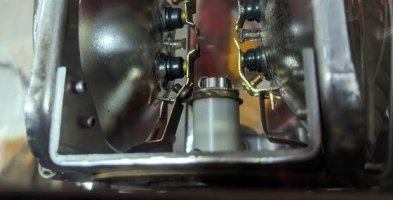
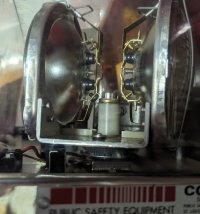
And here are the catalog pages
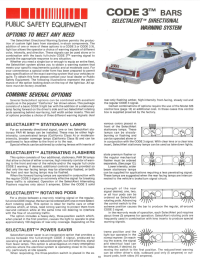
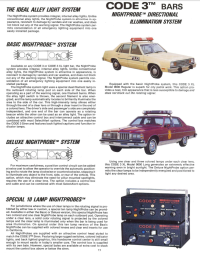

Last edited:
Very impressive. How does it work? It is Jetsonic-ish with the pods stopping at the right spot.
As John said!There were multiple varieties, but all are belt drive systems with copper contact discs and power brushes protruding down from the bottom of the rotators. The contact plates were divided into sections. When different sections were deenergized the bulbs would go out. The motor would be started and stopped by what the contacts were touching from what I remember too. I may be wrong but I do not recall any feature that didn't somehow use the contact discs in some way. ...
An important detail of the Nightprobe are the built-in diodes. These separate or connect the different sections/contacts depending on the applied potential (ground and +12V in different combinations).
The bars were prepared for this. To use this option you only needed the (more expensive) deluxe controller.... The deluxe models became more advanced with a control to forward and backward advance the lights and make them take downs on clear dome bars. ...
Unfortunately I couldn't find a NightProbe controller yet - so I'll probably have to build one. Then of course with the deluxe option.
At the moment my controller looks like this:

Do you know if the bars were marked somehow?My first lightbar was exactly like this, from some agency in Wisconsin. Red/Blue, clear ends and all... it was around 1987 or so; I believe Wisconsin went to the Red/Blue c. 1984.
Nice. Maybe that's it.
That "controller" looks exactly like the one that was posted years ago, lol (clamping wires to wires). You can actually make a home brew deluxe controller with standard switches and momentary switches. How..... I am not 100% sure. I know one of the deluxe controllers had a switch for activation of select alert, a switch for night probe, and a momentary button to "jog" the lights forwards and backwards. I want to say some systems used double throw momentary switches to jog the system forwards and backwards instead of two push button momentary switches.As John said!
An important detail of the Nightprobe are the built-in diodes. These separate or connect the different sections/contacts depending on the applied potential (ground and +12V in different combinations).
The bars were prepared for this. To use this option you only needed the (more expensive) deluxe controller.
Unfortunately I couldn't find a NightProbe controller yet - so I'll probably have to build one. Then of course with the deluxe option.
At the moment my controller looks like this:
View attachment 243745
The diodes between features were important and something I forgot about mentioning. I know in the jet bars they are what allow the motor brake to work quickly without shorting to ground. I think in these bars they allow for the switches to control the same feature without "backfeeding". I wish I had a schematic. I believe the diodes used worked out to being replaceable with the ones I linked below, or at least these worked for me in all my "smart bar" projects
Those are rated 15 amps at 45vdc or better stated over 50 amps at 12vdc so they are actually overkill, but they last longer and the wire ends are long and bend without breaking. I keep a pack of these on hand.
The design was ingenious IMHO, I just wish they would have put out better sales, end user, and shop info instead of the single page wordy catalog entry and a shop guide telling you to mail the 70lb bar back to them. There was nothing in these that a good radio shop could not have replaced. Now a multiplexed "smart" jetsonic actually had a microprocessor and worked like a serial edge and needed to go to FedSig. These Code 3 bars were strictly normal dc "magic".
I think these also suffered what I call the "fate of the arrow stick". That is to say the average user doesn't utilize the features and they stay in center-out or flash (arrow stick) or in this case they are either on or off (jog ignored) of ignored totally and the pillar spotlight used.
If we can make a schematic for these I would love to sticky the thread.
As far as I know, the basic controller had a 3-position (0-1-2) main switch for selectalert and full 360° warning (Beacon) and per side a double row 2-positon switch for activation the NightProbe Option.That "controller" looks exactly like the one that was posted years ago, lol (clamping wires to wires). You can actually make a home brew deluxe controller with standard switches and momentary switches. How..... I am not 100% sure. I know one of the deluxe controllers had a switch for activation of select alert, a switch for night probe, and a momentary button to "jog" the lights forwards and backwards. I want to say some systems used double throw momentary switches to jog the system forwards and backwards instead of two push button momentary switches.
To ensure that all functions work properly and do not influence each other, at least 2 additional relays and some diodes must have been installed. (I'm still tinkering with it)
The deluxe Option added per side a double row momentary switch and a relay with at least 3 changeover switches to the internals of the controller.
Here is the schematic out of the patent
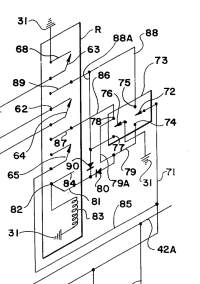
Works like a power window, Only with the difference that the motor is separated by the relay as soon as the night probe is swiveled forwards and backwards. This is to prevent the motor from automatically returning to the parking position as soon as it has left it due to manual "jog" operation.
Yes, these diodes work and in the later SD and XL bars they were also used that way, but in the early SD bar they used a different type/design.The diodes between features were important and something I forgot about mentioning. I know in the jet bars they are what allow the motor brake to work quickly without shorting to ground. I think in these bars they allow for the switches to control the same feature without "backfeeding". I wish I had a schematic. I believe the diodes used worked out to being replaceable with the ones I linked below, or at least these worked for me in all my "smart bar" projects
https://www.amazon.com/dp/B07NS63XJH/?tag=elightbars-20
Those are rated 15 amps at 45vdc or better stated over 50 amps at 12vdc so they are actually overkill, but they last longer and the wire ends are long and bend without breaking. I keep a pack of these on hand.
The originals were gone so I used a similar type:
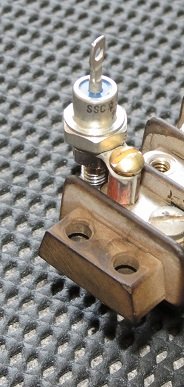
I'm in the process of creating one!If we can make a schematic for these I would love to sticky the thread.
Last edited:
Mine was not marked. I bought it from Streicher's in Milwaukee c.1987 ... anyone that knows the place might remember Fred. He sold it to me on the 30/30 Warranty: 30 feet or 30 seconds, whichever comes first. No idea where it came from.Do you know if the bars were marked somehow?
My friend bought a Red/Red CTS at the same time. It was the old shop, downstairs, and the stairs were parallel to the front window. On that wall were a dozen or more similar trade-ins looking out the window.
I, of course, traded it in later for a brand new DashMaster and one of those PAR36 handheld spotlight/flashing light coiled cord magnet things.
Here is just a quick drawing for a SD Bar with Standard inboard Pod + Nightprobe on the outboard (with 2 brushes) and deluxe Option
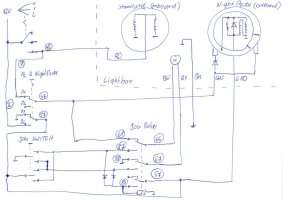
I think this is how it should work and I hope it is usable.
The drawing is just for the driver's side (wire color) and must still be transferred to the passenger side (same wire colors just with a black line).
The number in the circles are reference to the schematic out of the patent.
A drawing for a SD Bar with SelectAlert rotating Pod (inboard) + NightProbe with 2 brushes (outboard) and deluxe Option (like mine) is in progress.

I think this is how it should work and I hope it is usable.
The drawing is just for the driver's side (wire color) and must still be transferred to the passenger side (same wire colors just with a black line).
The number in the circles are reference to the schematic out of the patent.
A drawing for a SD Bar with SelectAlert rotating Pod (inboard) + NightProbe with 2 brushes (outboard) and deluxe Option (like mine) is in progress.
Last edited:
Yes, that's one of those relays I meant!Your info sounds correct. Good luck and keep us updated.
I found these too... looks like a relay in the bar near the rotator on this one.View attachment 243763View attachment 243764View attachment 243765View attachment 243766
But this is a XL Bar with 10-lamp Nightprobe (outboard) + SelectAlert rotating Pod (inboard)
The wiring is still a little mystery to me but as far as I could find out, the wiring is completely different to the early SD. There are fewer wires coming out of the XL bar and they are probably not designed for the deluxe Option.
Completely different is probably a stretch. The location of the relays, what diodes they used, where are they placed the diodes and relays, and the method by which the motor was stopped I believe is different. But once you graduated to 10 lamps, the idea stayed the same. So I believe the mechanism by which it was done, meaning what the relays and diodes do, stayed very similar. Also keep in mind that during that time period the pods went through three different designs.
Here is a drawing for a SD Bar with SelectAlert rotating Pod (inboard) + NightProbe with 2 brushes (outboard) and deluxe Option (like mine)
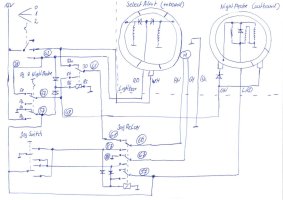
I think this is how it should work and I hope it is usable.
The drawing is just for the driver's side (wire color) and must still be transferred to the passenger side (same wire colors just with a black line).
The number in the circles are reference to the schematic out of the patent.
What I don't like is: The bulbs of the inner lamp holder continue to light up when NightProbe is activated (depending on the activated warning mode).
Can anyone tell me if that was the case?

I think this is how it should work and I hope it is usable.
The drawing is just for the driver's side (wire color) and must still be transferred to the passenger side (same wire colors just with a black line).
The number in the circles are reference to the schematic out of the patent.
What I don't like is: The bulbs of the inner lamp holder continue to light up when NightProbe is activated (depending on the activated warning mode).
Can anyone tell me if that was the case?
I remember seeing a older style with a round top, just like the bottom portion (not individual tabs) . I Might be an incorrect memory or homemade fix. The two you posted are the two official sealed beam styles, I just thought there was another variation on the round base style.Three? I only know these two:
First design -1979
View attachment 243781
Quick change lamp holder 1979-
View attachment 243780
What is the third one?
Last edited:
Unfortunately I couldn't find a NightProbe controller yet - so I'll probably have to build one. Then of course with the deluxe option.
I've never seen those controllers before. A neat response to the old trick of bolting driving lights to the exterior mounts that many agencies employed back in the day.
I've never seen those controllers before. A neat response to the old trick of bolting driving lights to the exterior mounts that many agencies employed back in the day.
Ok, so Mandela effect maybe? I was very sure there was a version of the round base style with a round top of the same diameter (not tabs sticking off) where you had to loosen the whole top. I can't find any pictures so I guess it is a false memory. Two rotator types seems to be the correct info.Three? I only know these two:
First design -1979
View attachment 243781
Quick change lamp holder 1979-
View attachment 243780
What is the third one?
Due to the assumption that they used the same housings for the controllers and switch boxes, I also took the back of the switch box as a template for my controller replica.
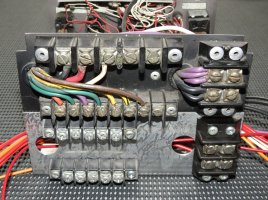
It's still the test piece to see how everything fits together - so not all dimensions are correct yet.
I actually need 2x 8 pole terminal strips - but at the moment I only have some 5 poles.
Without the deluxe option, 5 poles per terminal strip are enough - with deluxe option there must be at least 6.
to be continued ...

It's still the test piece to see how everything fits together - so not all dimensions are correct yet.
I actually need 2x 8 pole terminal strips - but at the moment I only have some 5 poles.
Without the deluxe option, 5 poles per terminal strip are enough - with deluxe option there must be at least 6.
to be continued ...
I got the basic wiring diagram of the Nightprobe option from the patent. Then I added the Select-Alert rotators into the schematic.... How did you figure out the proper schematics?
The difficulty was to make sure that everything works safely with every combination of the operating modes and that there are no short circuits (or similar). Was a bit of trial and error.
But I don't know if the circuit (in terms of function) is the same as the original, because I've never seen an original controller in operation.
In Canada, the Code 3 SD light bars were imported by Dominion Auto. I saw a few of them on fire engines and tow trucks.This back when Code 3 was really leading the industry in some areas. I miss old Code 3. Thanks for keeping a chunk of old Code 3 alive.


